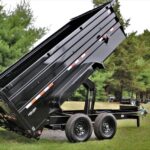Flatbed Trailer: Your Gateway to Trailer Expertise! If you are in the transportation or logistics industry, or simply curious about the world of trailers, then this blog post is for you! In this article, we will explore the ins and outs of gooseneck flatbed trailers – their uses, differences from trucks, dimensions, and weight. We will also discuss the best practices for transporting loads on these versatile trailers. So, whether you are a trucking enthusiast or a professional looking to expand your knowledge, keep reading to learn everything you need to know about gooseneck flatbed trailers.
Gooseneck Flatbed Trailer
Gooseneck flatbed trailer is a type of trailer commonly used for transporting heavy equipment, machinery, and other large loads. It is characterized by a unique hitching system that connects to the bed of a pickup truck or a special gooseneck hitch on a semitrailer truck. The gooseneck hitch is located in the bed of the truck, creating a center pivot point for the trailer. This design provides better maneuverability and stability compared to other types of trailers.
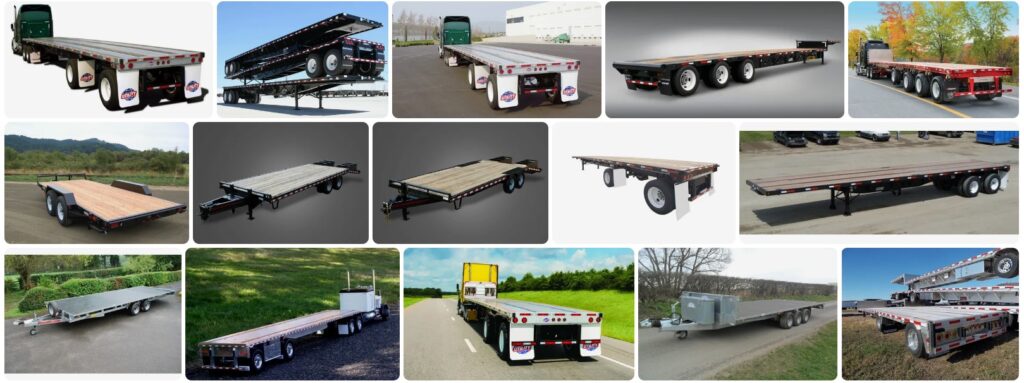
Gooseneck flatbed trailer is typically used for hauling construction equipment, agricultural machinery, and large vehicles such as trucks or buses. The gooseneck hitch allows for a higher weight capacity and distributes the weight evenly between the trailer and the towing vehicle. This makes it ideal for carrying heavy loads while maintaining stability and control during transportation.
Gooseneck flatbed-trailer remarkable advantages continues. One of key advantages is its versatility. The flatbed design provides a spacious and open platform for loading and securing various types of cargo. With the absence of side walls and a roof, the trailer allows for easy loading and unloading of oversized or irregularly shaped items such as building materials, lumber, or machinery.
Gooseneck Flatbed Trailers: Power, Durability, and Cargo Capabilities:
- Gooseneck trailers are also known for their durability and strength. They are built to withstand heavy loads and harsh road conditions. The frame and structure of the trailer are usually made from high-quality steel or aluminum, which ensures longevity and resistance to rust and corrosion.
- Additionally, gooseneck flatbed-trailers come in different lengths and widths to accommodate various types of cargo. The length of a flatbed trailer can range from 20 feet to over 50 feet, while the width can vary between 8 feet and 8.5 feet. These dimensions provide ample space for transporting large and wide loads.
Overall, a gooseneck flatbed-trailer is an essential tool for transporting heavy equipment and large loads. Its unique gooseneck hitching system, versatility, and durability make it a preferred choice for industries such as construction, agriculture, and logistics. Whether it’s hauling machinery to a construction site or delivering building materials to a project, a gooseneck flatbed-trailer is a reliable and efficient solution.
| Topic | Keyword |
|---|---|
| Gooseneck Flatbed-Trailer | gooseneck flatbed trailer |
| Uses of Flatbed-Trailer | transporting heavy equipment, machinery, large loads |
| Flatbed vs. Truck | difference between flatbed and truck |
| Flatbed-Trailer Width | width of flatbed trailer |
| Flatbed-Trailer Length | length of flatbed trailer |
| Flatbed-Trailer Weight | weight of flatbed trailer |
| Transporting Load on Flatbed Trailer | transporting load on flatbed trailer |
What is a Flatbed Semi Trailer?
A flatbed semi trailer is a type of trailer that has an open deck with no roof or sides. It is commonly used in the transportation industry to carry oversized or heavy loads that cannot be accommodated by a standard enclosed trailer. These trailers are designed to carry a wide range of goods, including construction materials, machinery, vehicles, and other large or irregularly shaped items. The open design of the flatbed trailer allows for easy loading and unloading, and provides greater flexibility in terms of cargo size and weight.
One of the main advantages of using a flatbed semi trailer is its versatility. The open deck design allows for the transportation of goods that may be too large or bulky to fit inside a standard enclosed trailer. This makes flatbed trailers particularly well-suited for industries such as construction, agriculture, and manufacturing, where oversized or irregularly shaped items are commonly transported.
In addition to their versatility, flatbed semi trailers also offer several other benefits. For example, the open deck design makes it easier to secure the cargo using straps, chains, or other tie-downs. This ensures that the load remains stable and secure during transit, reducing the risk of damage or accidents. The lack of a roof or sides also allows for easier inspection and access to the cargo while in transit.
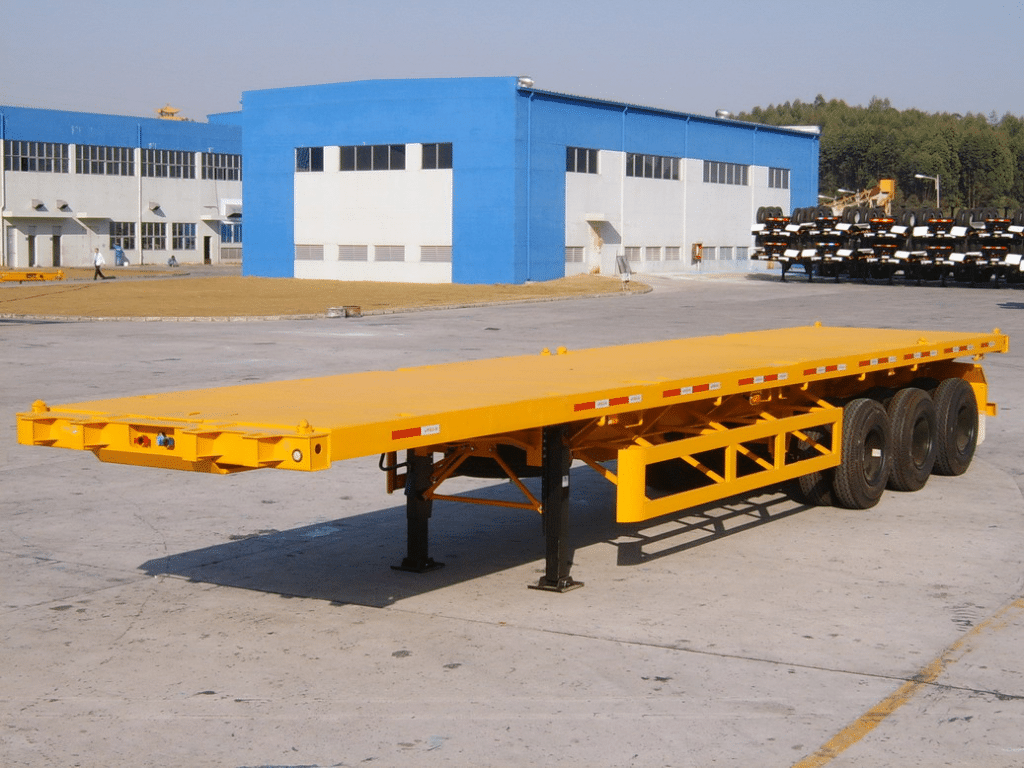
- Some key features of a flatbed semi trailer include:
| Length: | The typical length of a flatbed trailer ranges from 48 to 53 feet. |
| Width: | The standard width of a flatbed trailer is 8.5 feet. |
| Weight Capacity: | Flatbed trailers can typically carry loads weighing up to 48,000 pounds. |
| Construction: | Flatbed trailers are usually made of steel or aluminum for durability. |
Overall, the flatbed semi trailer is a highly versatile and practical option for transporting oversized or heavy loads. Its open deck design allows for easy loading and unloading, and its flexible cargo capacity makes it suitable for a wide range of industries. Whether you need to transport construction materials, machinery, or other large items, a flatbed semi trailer provides a reliable and efficient solution.
What is Difference Between a Flatbed Trailer and a Truck?
A flatbed-trailer is a type of trailer that is used for transporting heavy or oversized cargo. It is a flat, open platform with no sides or roof, designed to carry large and bulky items that cannot fit inside a standard enclosed trailer. On the other hand, a truck, also known as a tractor-trailer or a semi-truck, is the vehicle used to pull the flatbed trailer. It is made up of a cab, where the driver sits, and a separate trailer attached to the cab, which carries the cargo.
One key difference between a flatbed-trailer and a truck is their respective structures. As mentioned earlier, a flatbed trailer is essentially an open platform, whereas a truck consists of a cab and a separate trailer. The main purpose of a flatbed trailer is to provide a stable surface for transporting cargo, while a truck is responsible for providing the power and maneuverability needed to move the trailer and its load. This structural distinction allows for flexibility in the types of cargo that can be transported using a flatbed trailer, as it can accommodate items of various shapes and sizes.
Another difference between a flatbed-trailer and a truck is their overall dimensions. While a truck typically has a standard size and length, a flatbed trailer can vary in size depending on its specific application. The width of a flatbed-trailer is usually standardized to accommodate the width of standard shipping containers, which is 8.5 feet. However, the length of a flatbed-trailer can range anywhere from 20 feet to 53 feet, allowing for the transportation of different sizes of cargo. Some flatbed-trailers also have the ability to extend their length to accommodate longer loads.
- In conclusion, the main difference between a flatbed-trailer and a truck lies in their respective structures and dimensions. A flatbed-trailer provides an open platform for carrying bulky or oversized cargo, while a truck serves as the power unit to move the trailer. The flatbed-trailer offers flexibility in terms of the types of cargo it can transport, thanks to its open design. Additionally, the dimensions of a flatbed-trailer can vary, allowing for the transportation of different sizes of cargo. Understanding these differences is crucial when it comes to planning and executing the transportation of goods using a flatbed trailer.
How Wide is a Flatbed Trailer?
A flatbed trailer is a type of trailer that has a flat, open bed with no sides or roof. It is commonly used for transporting large and heavy goods, such as construction materials, machinery, and vehicles. Flatbed-trailers are known for their versatility and are often used in industries like construction, agriculture, and transportation.
The width of a flatbed-trailer can vary depending on its design and purpose. In general, flatbed- trailers are available in different widths to accommodate various types of loads. The standard width of a flatbed-trailer is typically around 8.5 feet or 102 inches. However, there are also wider options available, such as trailers with a width of 102-106 inches or even wider ones for specialized purposes.
The width of a flatbed trailer is an important factor to consider when planning a load. It determines the maximum width of the cargo that can be safely transported. It is crucial to comply with the regulations and guidelines regarding load width to ensure safe and legal transportation.
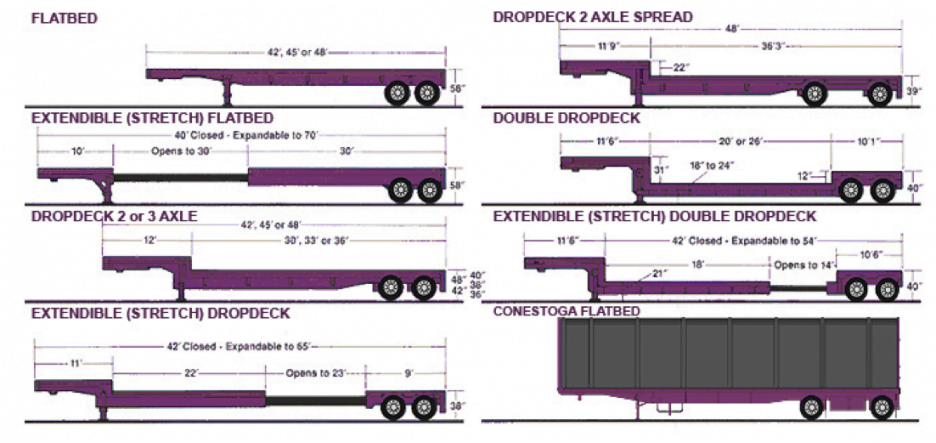
- Factors to consider when determining the width of a flatbed-trailer include:
- Legal restrictions: Each jurisdiction may have specific regulations regarding maximum load width on public roads. It is important to comply with these regulations to avoid penalties and ensure the safety of the load and other road users.
- Load dimensions: The width of the cargo being transported must be taken into account when selecting a flatbed trailer. It is essential to choose a trailer width that can accommodate the load without exceeding legal limits.
- Stability and balance: The width of the load should also be considered in relation to the trailer’s stability and balance. A wider load may require additional securing measures to prevent shifting and maintain stability during transit.
| Flatbed Trailer Width | Common Load Types |
|---|---|
| 8.5 feet or 102 inches | Standard loads and materials |
| 102-106 inches | Wider loads, oversized equipment |
| Specialized widths | Specific industry requirements |
In conclusion, the width of a flatbed-trailer can vary, with the standard width typically being around 8.5 feet or 102 inches. However, there are wider options available for specialized purposes. When determining the width of a flatbed-trailer, it is important to consider legal restrictions, load dimensions, and stability. By choosing the appropriate width, you can ensure safe and efficient transportation of your cargo.
How Long is a Flatbed Trailer?
A flatbed trailer is a type of trailer that does not have any sides or roof. It consists of a flat, open platform that is used for transporting various types of cargo. One of the most common questions that people have about flatbed-trailers is how long they are. The length of a flatbed trailer can vary depending on the specific model and manufacturer, but they generally range from 48 feet to 53 feet in length.
Flatbed trailers are commonly used in the transportation industry to haul oversized or heavy cargo. They are designed to provide a sturdy and stable platform for carrying loads that are too large or heavy to be transported by other means. The length of a flatbed trailer is an important consideration when determining whether or not it will be suitable for a particular job.
There are several factors that can affect the length of a flatbed trailer:
- In addition to the cargo type, regulations and laws also play a role in determining the length of a flatbed trailer. In many countries, there are restrictions on the maximum length of trailers that can be used on public roads. These regulations are in place to ensure safety and prevent excessive strain on the road infrastructure. It is important to check the local regulations and requirements before selecting a flatbed trailer.
| Trailer Type | Length Range |
|---|---|
| Standard Flatbed Trailer | 48-53 feet |
| Extendable Flatbed Trailer | 45-80 feet |
| Stretch Flatbed Trailer | 48-80 feet |
In addition to the standard flatbed trailer, there are also extendable and stretch flatbed trailers available. These types of trailers are designed to provide additional length when needed. The extendable flatbed trailer can be adjusted to a range of lengths, usually between 45 and 80 feet. The stretch flatbed trailer, on the other hand, is typically fixed at a length of 48 feet but can be stretched to up to 80 feet.
In conclusion, the length of a flatbed trailer can vary depending on the specific model, manufacturer, and the type of cargo being transported. Standard flatbed trailers generally range from 48 to 53 feet in length, but there are also extendable and stretch flatbed trailers available for transporting longer or oversized cargo. It is important to consider the local regulations and requirements when selecting a flatbed trailer to ensure compliance and safety.
How much does a Flatbed Trailer Weigh?
Flatbed trailer is a type of trailer that has an open, flat deck with no sides or roof, allowing for easy loading and unloading of cargo. It is commonly used for transporting large and heavy items that cannot be accommodated in a traditional enclosed trailer or shipping container. Flatbed trailers come in various sizes and configurations, but one important consideration when using them is their weight.
The weight of a flatbed trailer can vary depending on its design, size, and the materials used in its construction. Typically, the weight of an empty flatbed trailer ranges from 8,000 to 12,000 pounds. This weight includes the trailer frame, axles, wheels, and other essential components. However, it is important to note that this is just the base weight of the trailer and does not take into account any additional equipment or cargo that may be loaded onto it.

When determining the total weight of a loaded flatbed trailer, it is essential to consider both the weight of the cargo and any additional equipment or accessories that are attached to the trailer. This can include items such as straps, chains, tarps, or toolboxes. All of these add-ons can contribute to the overall weight of the trailer and must be taken into account to ensure safe and legal transportation.
In addition to the weight of the cargo and accessories, it is important to consider the weight distribution on a flatbed trailer. Proper weight distribution is crucial for safe handling and stability while on the road. Uneven weight distribution can lead to imbalanced loads, increased risk of tipping or flipping, and potential damage to the trailer and cargo. It is recommended to distribute the weight evenly across the trailer’s deck and secure the load properly to prevent shifting during transit.
How Should You Transport a Load on a Flatbed Trailer?
A flatbed trailer is a type of trailer that is specifically designed to transport large and heavy loads. It consists of a flat, open deck with no sides or roof, allowing for easy loading and unloading of cargo. This type of trailer is commonly used in industries such as construction, manufacturing, and agriculture, where oversized or irregularly-shaped items need to be transported.
When it comes to transporting a load on a flatbed trailer, there are several important factors to consider. First and foremost, it is crucial to properly secure the load to prevent it from shifting or falling off during transportation. This can be done by using various types of tie-downs, such as straps, chains, or ropes, depending on the nature and size of the cargo. Additionally, the load should be evenly distributed on the trailer to ensure stability and prevent overloading or exceeding weight limits.
Another important aspect of transporting a load on a flatbed trailer is to make sure that the cargo is properly protected from the elements. Since a flatbed trailer does not have any sides or roof, it is exposed to weather conditions such as rain, wind, and sunlight. To protect the load, it is advisable to use appropriate coverings, such as tarps or shrink wrap, to shield it from moisture, wind, and excessive sunlight exposure.
Furthermore, it is essential to comply with all applicable laws and regulations when transporting a load on a flatbed trailer. This includes securing the necessary permits, following weight restrictions, and adhering to any required safety precautions. It is also important to regularly inspect the flatbed trailer for any signs of wear and tear, and to perform routine maintenance to ensure its safe and efficient operation.
Transporting Oversized Loads
Transporting oversized loads on a flatbed trailer requires additional considerations. Oversized loads typically exceed the standard legal dimensions for height, width, and length. Therefore, it is necessary to obtain special permits and adhere to specific routing guidelines when transporting such loads. In some cases, escort vehicles may be required to accompany the flatbed trailer to ensure the safety of the load and other road users.
Conclusion
Transporting a load on a flatbed trailer requires careful planning and attention to detail. Properly securing the load, protecting it from the elements, and complying with relevant laws and regulations are crucial for a safe and successful transport. Whether it is transporting regular or oversized loads, a flatbed trailer provides a versatile and efficient solution for transporting a wide range of goods in various industries.
Frequently Asked Questions
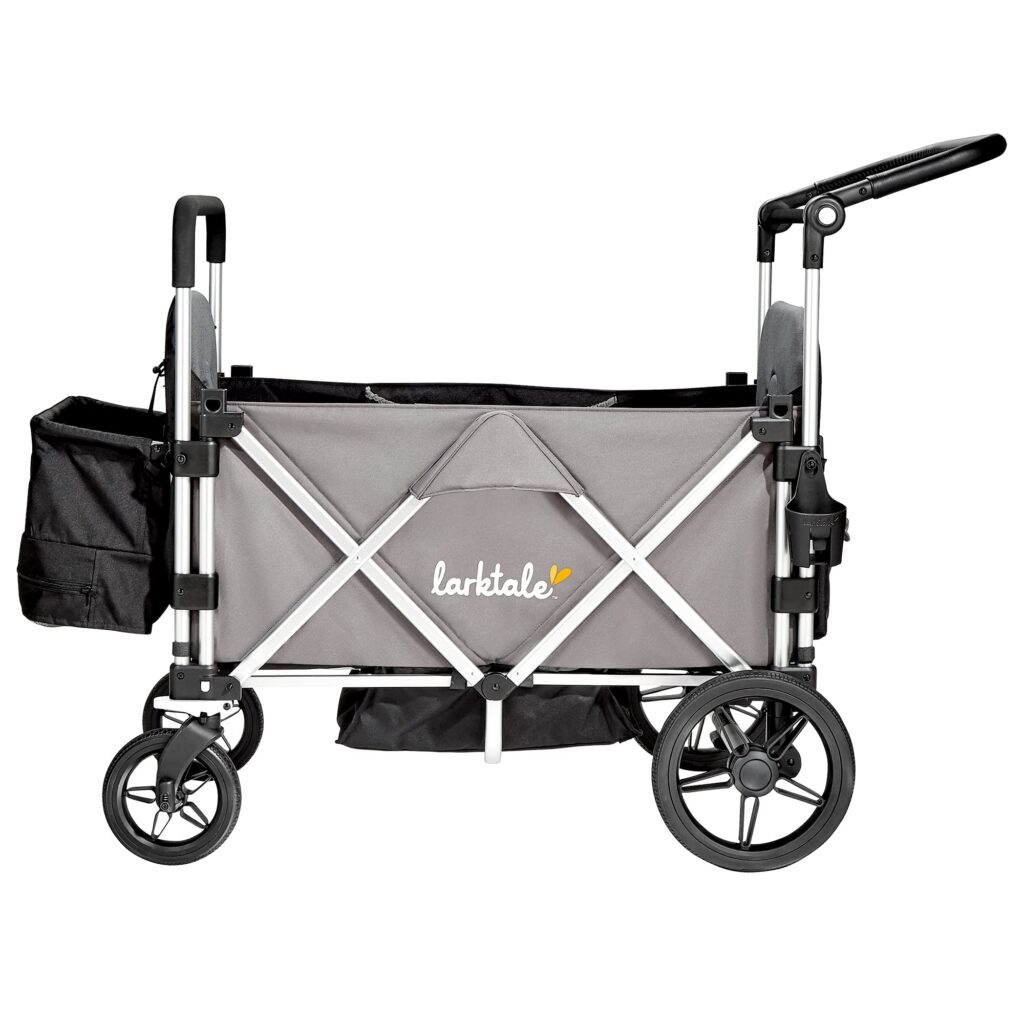
Larktale Caravan 2023: Discover the dimensions, accessories, and more. Embark on outdoor adventures with the best gear. Learn more now!
Larktale Caravan 2023: A Triumph of Innovation and Adventure



